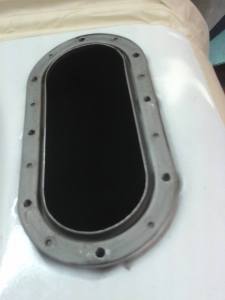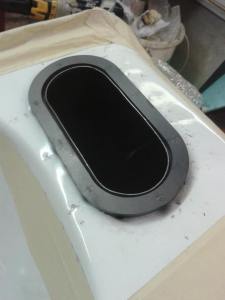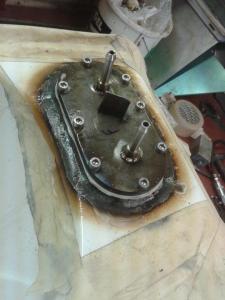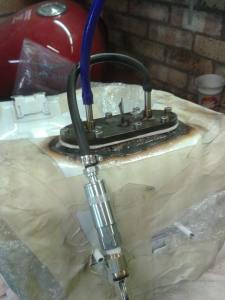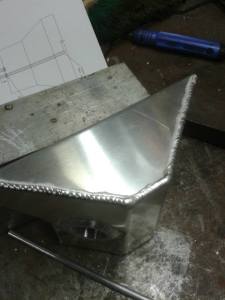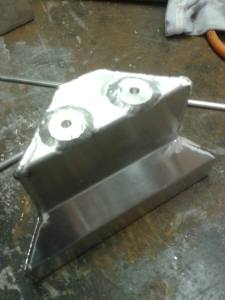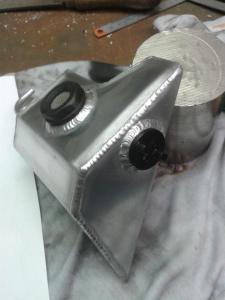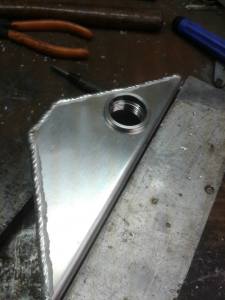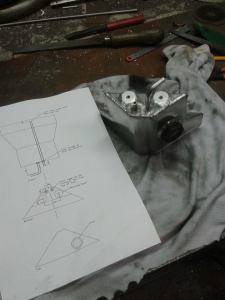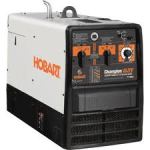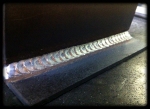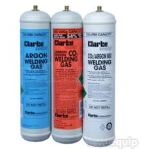Suzuki Srad Fuel Tank Pump Flange Modifications
A typical fault with the Suzuki SRAD tank was the pump seal arrangement on the bottom of the tank.
If the pump and flange plate were removed for any reason and then refitted, there was a big chance that with a fraction excessive tightening of the clamp bolts that the spot welded flange would distort and then the sandwiched seal ring would not pull tight against the flared opening flange of the tank.
Major problem if you had done the above, filled the tank and had fuel pouring out the bottom of the tank on a nice hot engine / gearbox casing. Very poor design by Suzuki really.
Anyway, my customer having spent a good wedge of cash on getting his tank repainted was left in the same position the first time he put new fuel in his nice newly painted tank. Upon inspection it could be seen that the flange the clamp bolts thread into had distorted and hence the seal ring was not sealing against the tank flange lip.
As can be seen from the image above the original set up takes the form of a 4mm thick flange that is spot welded to the main tank in between the threaded bolt positions, you may also be able to see the dimples in the tank under the positions where the clamping bolts sit through the flange so the bolts dont actually damage the tank shell. You can also see the pressed up flange around the opening that the seal ring actually seals against when the whole thing is tightened up. Clearly also shown are the positions where the spot welds have been positioned in between the drilled and tapped holes.
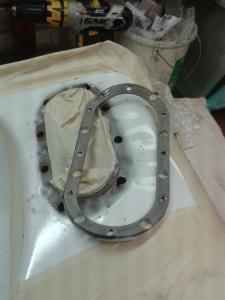 Above image shows where I have had to drill out the spot welds in the original flange in order to get the damn thing off – best spot welds I have ever removed! This took a bit of tugging and hammering to get off and the next image shows that I then had to do a little panel beating with a small aluminium block to level the panel work back up a bit.
Above image shows where I have had to drill out the spot welds in the original flange in order to get the damn thing off – best spot welds I have ever removed! This took a bit of tugging and hammering to get off and the next image shows that I then had to do a little panel beating with a small aluminium block to level the panel work back up a bit.
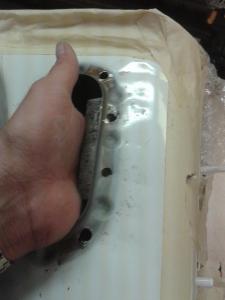 A little bit of flushing off and a bit of sanding down and cleaning up and we are ready to fit the new flange.
A little bit of flushing off and a bit of sanding down and cleaning up and we are ready to fit the new flange.
Laser cut, mild steel, thicker 6mm pump mounting flange offered up in place on the original tank. This will be tacked and welded in place using a 10mm thick top plate to help soak some heat away and to help stop the new flange from distorting whilst welding.
1st we need to drill and tap out the holes. Drill out 5mm (4.8mm actually) diameter in order to tap M6. I did this using a battery drill set at low torque setting to prevent breaking the tap off in the hole. Notice that I didnt get the holes laser cut as this leaves a “hard” surface on the material which is a nightmare to thread out then, so all I did was get the laser to put a cross mark exactly where the holes come, ensuring dead accurate marking.
 Once all the holes were drilled and tapped out, a double check on the orientation and bolt the blanking flange up, sett up on the tank for accurate tack up.
Once all the holes were drilled and tapped out, a double check on the orientation and bolt the blanking flange up, sett up on the tank for accurate tack up.
 Once tacked up, I removed the blanking plate and double checked the tack up and positioning. I had to make sure that I clamped the tank panel work tight up to the flange. Unfortunately even with the new flange tacked tight up I still had a gap to fill where the original dimples in the tank are, so I had to weld as cool as possible but a large fillet size to cover the dimples.
Once tacked up, I removed the blanking plate and double checked the tack up and positioning. I had to make sure that I clamped the tank panel work tight up to the flange. Unfortunately even with the new flange tacked tight up I still had a gap to fill where the original dimples in the tank are, so I had to weld as cool as possible but a large fillet size to cover the dimples.
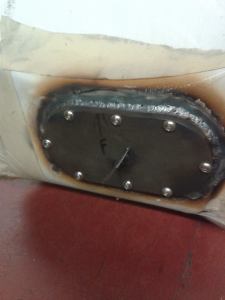 Once the weld had had time to cool down I removed the blanking plate, although the flange had stayed flat and level there was a bit of shrinkage in the panel work.
Once the weld had had time to cool down I removed the blanking plate, although the flange had stayed flat and level there was a bit of shrinkage in the panel work.
The blanking plate was the used as a template to make a silicon rubber seal for testing, I also had to drill the blank plate and weld 2 pipe stubs on so that I could connect an airline and pressure blow off valve.
The seal and clamping plate were bolted back in place and tightened up I connected an airline one side and a pressure relief blow off valve the other. Spraying soapy water around the welded area and then pressuring up the tank if there is a leak you can see air bubbles bubbling out of pinholes etc.
On to dry off, clean up, bit of paint and jobs a good un!
Just waiting for the laser cut nitrile seal to clamp up and finish the job.
———————————————————————————————————————————————–
For all your Custom Car & Motorcycle Parts Manufacture and Welding / Repairs
SEE –
www.flashcustoms.co.uk
Don`t forget to email or call us for all your custom made 1 off bespoke items.
Alloy welding / repairs, custom parts, Welding Instruction.
Thanks for reading our blog – we hope this has been of use to you.
Recommended sites
FLASH CUSTOMS – Specialist Custom Car & Motorcycle Parts
Automotive LED Lights – Car & Motorcycle LED Lighting Solutions
Loaded Wallet – Discount and cash back offers
Email – sales@flashcustoms.co.uk
——————————————————————————————————————————————————————
——————————————————————————————————
Can you write a simple blog ? You too could also be earning an income from blogging!

